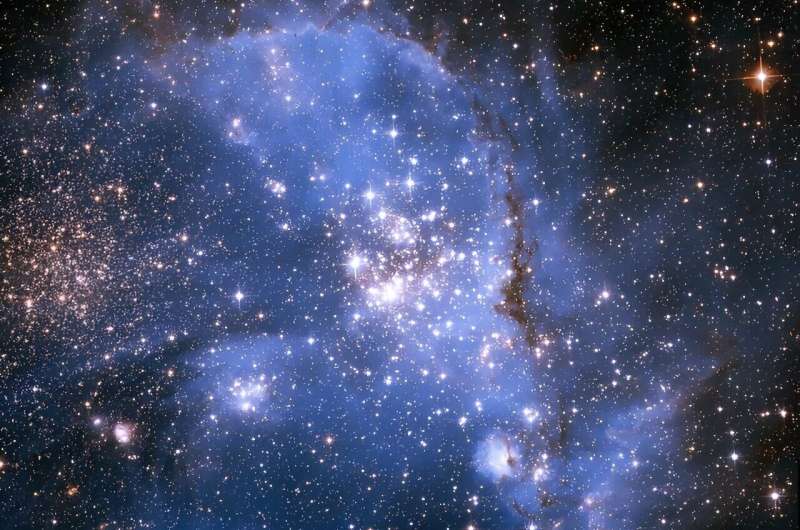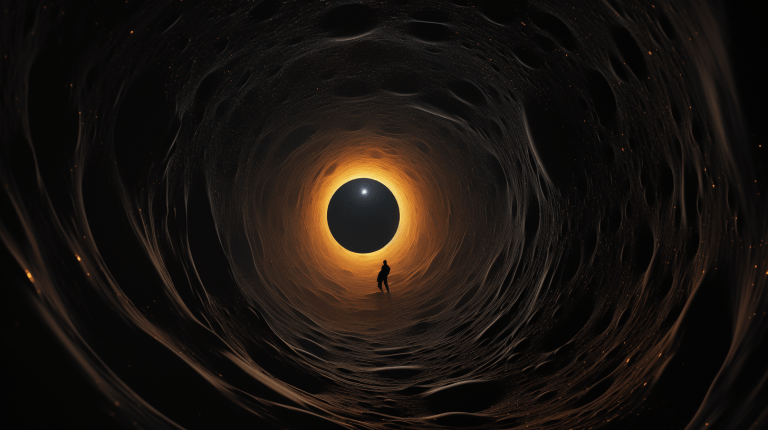First detection of massive magnetic stars outside our galaxy

The most massive star-forming region NGC346 in the Small Magellanic Cloud. Credit: NASA, ESA, A. James (STScI)
For the first time, magnetic fields have been detected in three massive, hot stars in our neighboring galaxies, the Large and Small Magellanic Clouds. While magnetically massive stars have already been detected in our galaxy, the discovery of magnetism in the Magellanic Clouds is particularly important because these galaxies have a strong population of young massive stars. This provides a unique opportunity to study stars in active form and the upper limit to the mass a star can have and remain stable.
In particular, magnetism is considered to be a key component in the mass evolution of stars, with far-reaching influence on their ultimate fate. They are massive stars with initially more than eight solar masses that leave neutron stars and black holes behind by the end of their evolution.
Spectacular merger events of such compact remnant systems have been observed by gravitational wave observers. In addition, theoretical studies propose a magnetic mechanism for the explosion of massive stars, relevant for gamma-ray bursts, X-ray flares, and supernovae.
“Studies of magnetic fields in massive stars in galaxies with young stellar populations provide crucial information on the role of magnetic fields in star formation in the early universe with star-forming gas that is not contaminated by metals,” says Dr. Swetlana Hubrig, from Leibniz. Institute for Astrophysics Potsdam (AIP) and first author of the study.
Stellar magnetic fields are measured using spectropolarimetry. For this, the circularly polarized light of the stars is recorded and the smallest changes in the spectral lines are investigated. However, to achieve the necessary accuracy of polarization measurements, this method requires high quality data.
“The method is extremely photon-hungry. This is a particular challenge because even the most luminous massive stars, which have more than eight solar masses, are relatively light-poor when viewed in our neighboring galaxies, the Large Clouds and of Magellan.” Dr. Silva Järvinen from AIP explains.
Because of these conditions, conventional high-resolution spectropolarimeters and smaller telescopes are unsuitable for such investigations. Therefore, the low-resolution spectropolarimeter FORS2, which is mounted on one of the four 8-meter telescopes of the European Southern Observatory’s (ESO) Very Large Telescope (VLT), was used.
Previous attempts to detect magnetic fields in massive stars outside our galaxy were unsuccessful. These measurements are complex and depend on several factors.
The magnetic field measured with circular polarization is called the longitudinal magnetic field and corresponds exclusively to the component of the field pointing in the direction of the observer. It is similar to the light coming from a lighthouse, which is easy to see when the beam shines towards the observer.
Because the magnetic field structure in massive stars is usually characterized by a global dipole with the axis inclined to the rotation axis, the longitudinal magnetic field strength can be zero at rotation phases when the observer is looking directly at the magnetic equator of rotation. star The detectability of the polarization signal also depends on the number of spectral features used to probe the polarization.
Observing a wider spectral region with a greater number of spectral features is preferable. In addition, longer exposure times are essential for recording polarimetric spectra with a sufficiently high signal-to-noise ratio.
Taking these important factors into account, the team conducted spectropolarimetric observations of five massive stars in the Magellanic Clouds. In two putative single stars with spectral characteristics typical of massive magnetic stars in our galaxy and in an actively interacting massive binary system located within the core of the most massive star-forming region NGC346 in the Small Magellanic Cloud, they managed to discover magnetic fields. of the order of the Gauss kilogram.
On the surface of our sun, such strong magnetic fields can only be detected in small highly magnetized areas – sunspots. The reported detections of the magnetic field in the Magellanic Clouds provide the first indication that massive star formation continues in galaxies with young stellar populations in a manner similar to our own.
The research is published in the journal Astronomy & Astrophysics.
More information:
S. Hubrig et al, Discovery of massive extragalactic magnetic stars, Astronomy & Astrophysics (2024). DOI: 10.1051/0004-6361/202449793
Provided by the Leibniz Institute for Astrophysics Potsdam (AIP)
citation: First detection of magnetic massive stars outside our galaxy (2024, May 29) Retrieved May 30, 2024 from https://phys.org/news/2024-05-magnetic-massive-stars-galaxy.html
This document is subject to copyright. Except for any fair agreement for study or private research purposes, no part may be reproduced without written permission. The content is provided for informational purposes only.
#detection #massive #magnetic #stars #galaxy
Image Source : phys.org





